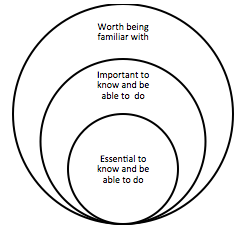Create a Standards-Based Integrated Performance Assessment Unit
Step-by-Step
Step 7: Identify Can-do Statements and Grammatical Structures/Patterns
At the beginning of this step-by-step process, you identified the Instructional Goals for your unit. Based on those goals, you designed the standards-based integrated performance assessment with performance tasks for each mode of communication. It is now time to consider what “tools” learners will need in order to successfully complete the performance assessment.
One set of “tools” is linguistic: can-do statements and related structures/patterns. A can-do statement describes how the grammatical structure or pattern will be used for communication. The structure/pattern is the grammar or sentence pattern that is used to communicate. For example, in the Chinese class, the students need to give directions from one place to another on a map of China. "I can give directions from one place to another in a city" is the can-do statement. In order to give directions, students need to be able to say "Go north, turn right, continue straight ahead." Those are the patterns they need to practice.
In this videoclip, the teachers also talk about the role of technology in their unit development. All of the teachers agreed that technology should only be used if it will enhance the unit in some way. It should not be used just because it is available.

Before watching the video
Think about how and why you use technology in your classroom. How does technology enhance what you are doing with the content you are teaching or with the process you have your students follow?

As you watch the video
As you watch the video, identify the can-do statements and related structures that the teachers identified for their units. Pay special attention to the teachers’ comments about the integration of technology as a tool. Note how they used technology in their units.
Functions and Structures/Patterns:
The Italian instructor indicated that the students had to give opinions and critiques related to movies that they viewed. In order to do this, they would need to use the subjunctive. She also said that the textbook is a useful tool for the students to review the subjunctive and practice the various forms.
Technology:
Italian unit:
Extensive use of the Internet for movie trailers, magazine articles about Italian cinema; students also needed to use videocameras to make their movies.
The teachers spoke of technology as a tool to engage the students, to reinforce what is being taught. They mentioned podcasts, videoclips, and websites.

After watching the video
 The videoclip displayed a graphic from Wiggins and McTighe, Understanding by Design (1998) intended to help teachers clarify content priorities for a unit of instruction (at right).
The videoclip displayed a graphic from Wiggins and McTighe, Understanding by Design (1998) intended to help teachers clarify content priorities for a unit of instruction (at right).
In order for students to successfully complete the performance assessment, it is helpful to think of the linguistic tools (can-do statements, grammatical patterns and structures) for a unit through this lens. Likewise, it is useful to think of the technology that students can access in terms of "essential," "important," or "worth being familiar with."
What are the tools (linguistic and technological) that your students need for a unit that you are currently teaching? How might you categorize those tools using this graphic?
